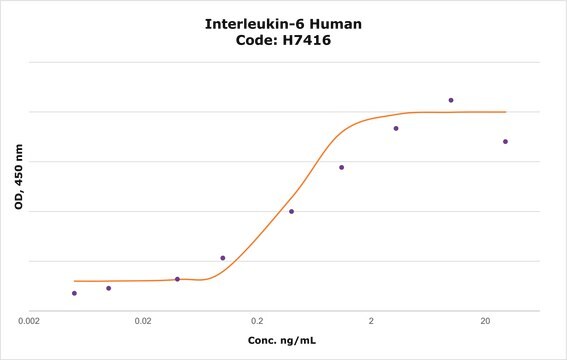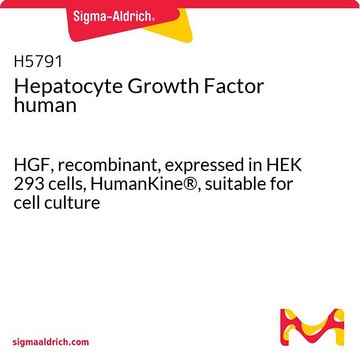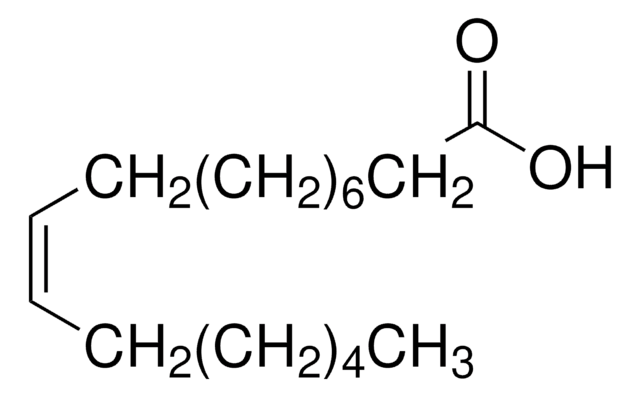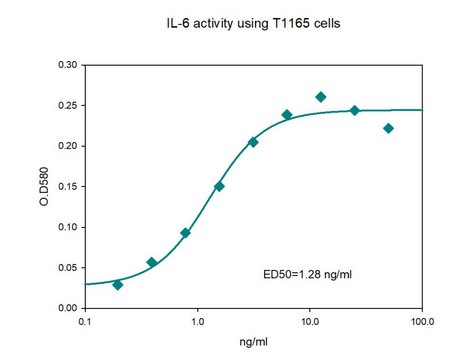H6541
Oncostatin M human
OSM, recombinant, expressed in HEK 293 cells, HumanKine®, suitable for cell culture
Sinonimo/i:
OSM
Autenticatiper visualizzare i prezzi riservati alla tua organizzazione & contrattuali
About This Item
Prodotti consigliati
Origine biologica
human
Livello qualitativo
Ricombinante
expressed in HEK 293 cells
Saggio
≥95% (SDS-PAGE)
Stato
lyophilized powder
Potenza
≤0.1-1.5 ng/mL EC50
Qualità
endotoxin tested
PM
dimer 30 kDa (glycosylated)
Confezionamento
pkg of 5X10 μg
pkg of 10 μg
tecniche
cell culture | mammalian: suitable
Impurezze
≤1 EU/μg
N° accesso UniProt
Temperatura di conservazione
−20°C
Informazioni sul gene
human ... OSM(5008)
Cerchi prodotti simili? Visita Guida al confronto tra prodotti
Azioni biochim/fisiol
Oncostatin M (OSM), LIF, G-CSF, IL-6, and CNTF are structurally related members of the same cytokine family sharing similarities in their primary amino acid sequences, predicted secondary structure, and receptor components. OSM is a growth-regulating cytokine, affecting a number of tumor and normal cells. This material was first identified by its ability to inhibit the growth of A375 melanoma cells and other human tumor cells, but not inhibit the growth of normal human fibroblasts. It acts synergistically with TGF β1 to inhibit the proliferation of tumor cells like A375 melanoma cells. It induces an increase in LDL receptor expression and LDL uptake by hepatoma cells. OSM activates synovial fibroblast-like cells to produce urokinase type plasminogen activator. OSM is secreted by macrophages and activated T lymphocytes.
Stato fisico
Lyophilized from a 0.2 μm filtered solution of 1x PBS.
Risultati analitici
The activity was determined by the dose-dependent stimulation of the proliferation of human TF-1 cells (humanerythroleukemic indicator cell line)
Note legali
HumanKine is a registered trademark of Proteintech Group, Inc. and Humanzyme, Inc
Codice della classe di stoccaggio
11 - Combustible Solids
Classe di pericolosità dell'acqua (WGK)
WGK 3
Punto d’infiammabilità (°F)
Not applicable
Punto d’infiammabilità (°C)
Not applicable
Scegli una delle versioni più recenti:
Possiedi già questo prodotto?
I documenti relativi ai prodotti acquistati recentemente sono disponibili nell’Archivio dei documenti.
Yuxin Wang et al.
Proceedings of the National Academy of Sciences of the United States of America, 110(42), 16975-16980 (2013-10-02)
The activation of STAT3 by tyrosine phosphorylation, essential for normal development and for a normal inflammatory response to invading pathogens, is kept in check by negative regulators. Abnormal constitutive activation of STAT3, which contributes to the pathology of cancer and
N Kanda et al.
Allergy, 67(6), 804-812 (2012-04-11)
Skin lesions with atopic dermatitis (AD) are associated with dysregulated expression of LL-37 and enhanced expression of IL-22, thymic stromal lymphopoietin (TSLP), IL-25, IL-31, and oncostatin M. Vitamin D3 enhances LL-37 production in keratinocytes. This study aimed to examine the
Andrea Rinaldi et al.
British journal of haematology, 163(2), 194-204 (2013-08-22)
In a fraction of patients, chronic lymphocytic leukaemia (CLL) can transform to Richter syndrome (RS), usually a diffuse large B-cell lymphoma (DLBCL). We studied genome-wide promoter DNA methylation in RS and clonally related CLL-phases of transformed patients, alongside de novo
Vicky Nicolaidou et al.
PloS one, 7(7), e39871-e39871 (2012-07-18)
A major therapeutic challenge is how to replace bone once it is lost. Bone loss is a characteristic of chronic inflammatory and degenerative diseases such as rheumatoid arthritis and osteoporosis. Cells and cytokines of the immune system are known to
Yu-Fan Chen et al.
Hepatology (Baltimore, Md.), 55(4), 1193-1203 (2011-11-19)
Liver transplantation is the only definitive treatment for end-stage cirrhosis and fulminant liver failure, but the lack of available donor livers is a major obstacle to liver transplantation. Recently, induced pluripotent stem cells (iPSCs) derived from the reprogramming of somatic
Il team dei nostri ricercatori vanta grande esperienza in tutte le aree della ricerca quali Life Science, scienza dei materiali, sintesi chimica, cromatografia, discipline analitiche, ecc..
Contatta l'Assistenza Tecnica.








